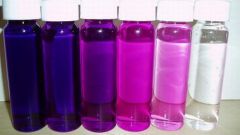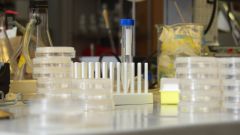You will need
- -the alkali solution, the exact concentration
- -burette
- -conical flasks
- -volumetric pipettes
- indicator
- -a set of hydrometers
Instruction
1
One of the most simple ways to determine the concentration of acid involves the direct titration (the process of gradual addition of solution of known concentration(titrant) to a solution of the analyte with the aim to fix the point of equivalence (end of reaction)). In this case it is convenient to use the neutralization with an alkali. Conclusion it can be easily identified by adding the indicator (for example, in acid phenolphthalein clear, and upon addition of alkali becomes crimson; methyl orange in acidic medium pink, and in alkaline - orange).
2
Take the burette (volume 15-20 ml), install it in the tripod using the legs. It should be clearly stated, otherwise, swinging of the tip can drop a few extra drops, which will spoil the whole process. Sometimes one drop changes the color of the indicator. This point need to be detected.
3
Please be ware and reagents conical flasks for titration (4-5 pieces of small volume), several pipettes (as Mora - without division, and dimensional), volumetric flask of 1 l, fiksanala alkali, indicator, distilled water.
4
Prepare a solution of precise concentration of alkali (e.g., NaOH). To do this, use fixanal (vial sealed it with a substance, which when diluted in 1 liter of water is obtained with a 0.1 normal solution). Of course, you can use the exact linkage. But the first option is more precise and more reliable.
5
Next, fill the burette with alkali. In a conical flask place 15 ml of unknown concentration of acid (possibly HCl) add 2-3 drops of the indicator. And proceed directly to the titration. As soon as the indicator changes color and approximately 30 will to remain so, stop the process. Write down how much was spent alkali (for example, 2.5 ml).
6
Then follow the course of the work another 2-3 times. This is done to obtain whiter the exact result. After calculate the average volume of alkali. Vav = (V1+V2+V3)/3, V1 is the result of the first titration, in ml V2 - is the result of the second, in ml, V3 - the third volume, ml 3 - number of performed reactions. For example, Vav = (2,5+2,7+2,4)/3 = 2,53 ml.
7
After the experiment, you can proceed to the main estimates. In this situation the relation is valid: C1*V1 = C2*V2 where C1 is the concentration of the alkali solution, normal (n), V1 is the average volume used in the reaction of alkali ml, C2 is the concentration of the acid solution, n, V2 - volume of acid involved in the reaction, ml. of the C2 - value is unknown. So, it must be expressed through the known data. C2 = (C1*V1)/V2, i.e., S2 = (0,1 * 2,53)/ 15 = 0,02 B. Conclusion: during the titration of HCl solution 0.1 n NaOH, was clarified by the concentration of the acid - 0.02 N.
8
Another common way to find out the concentration of the acid is, for starters, to know its density. To do this, purchase a set of hydrometers (in chemical or specialty store, you can also order online or visit terms of trade of facilities for motorists).
9
Pour acid into beaker and place in it the hydrometers as long as they will continue to sink or to be ejected to the surface. When the device will be like a float, select a numeric value on it. This figure is the density of the acid. Next, using the relevant literature (reference Lurie), is not difficult to determine in the table the desired concentration.
10
Regardless of which method you select, do not forget about safety.






